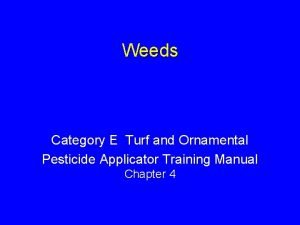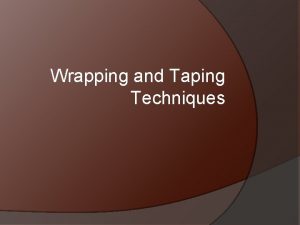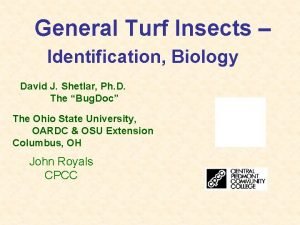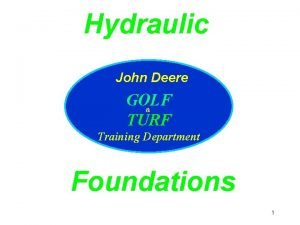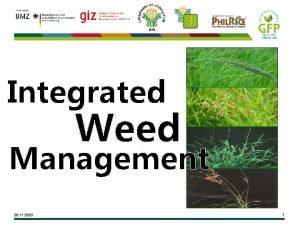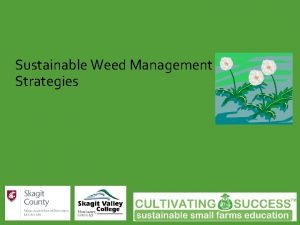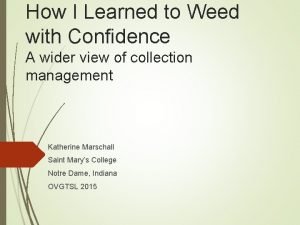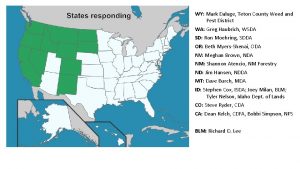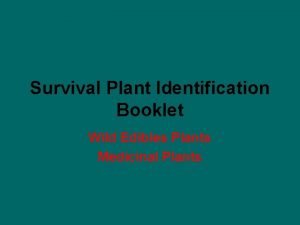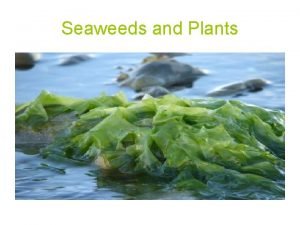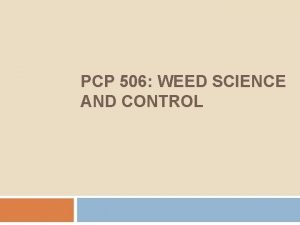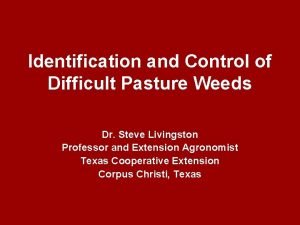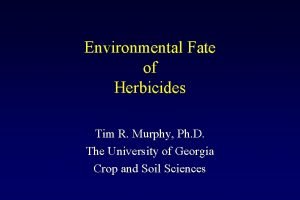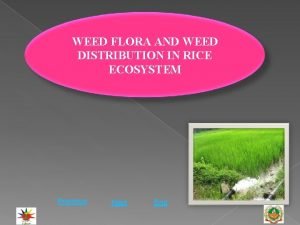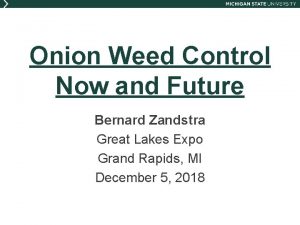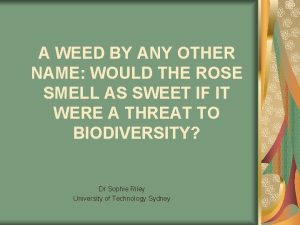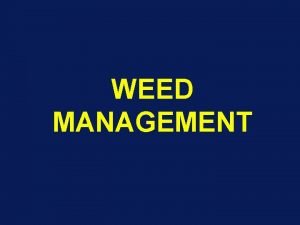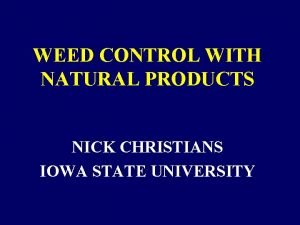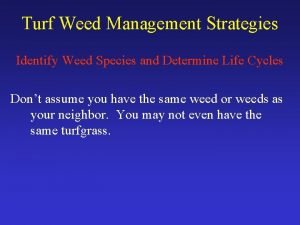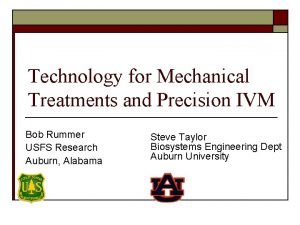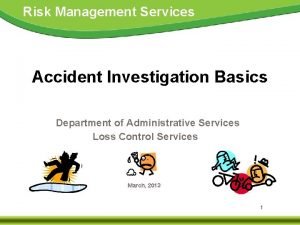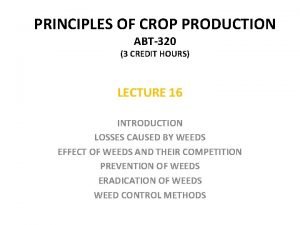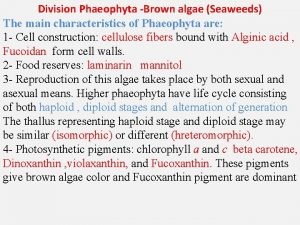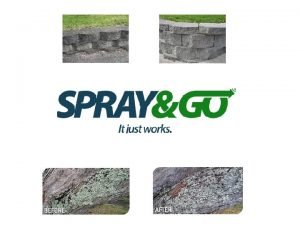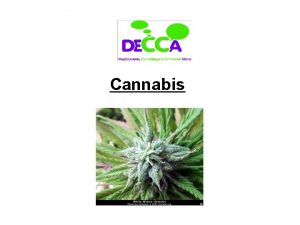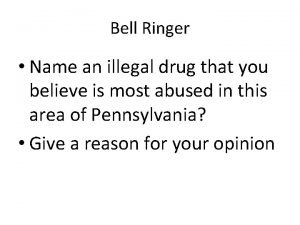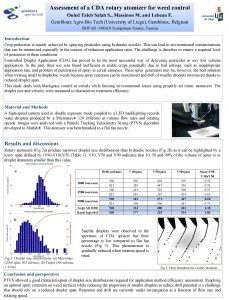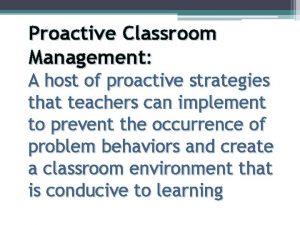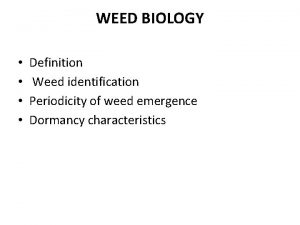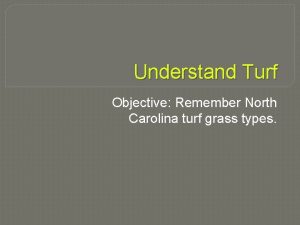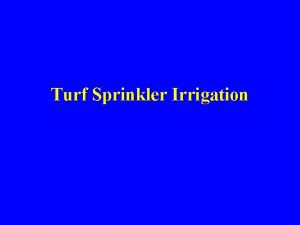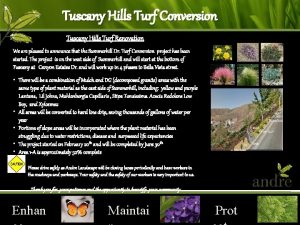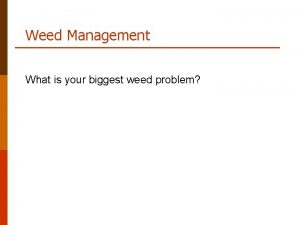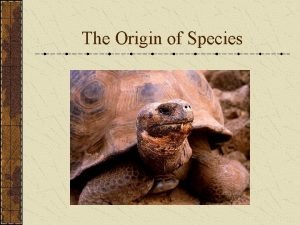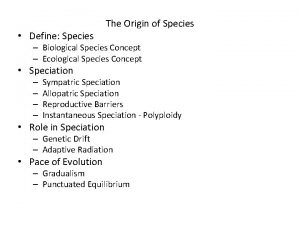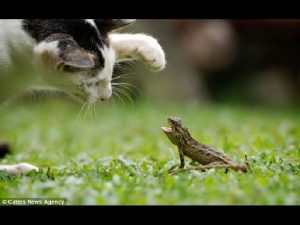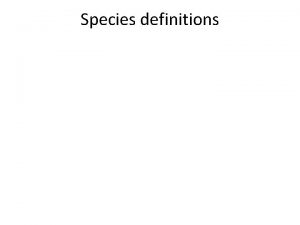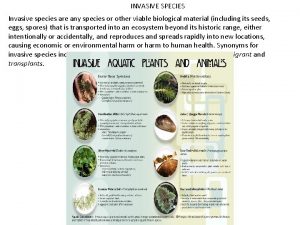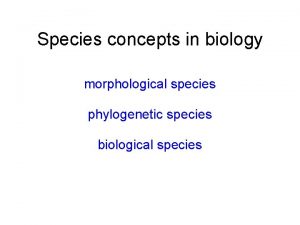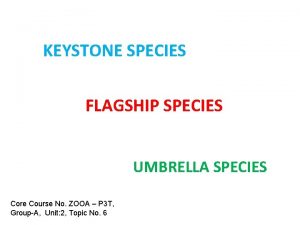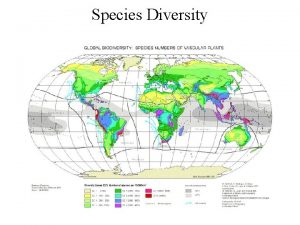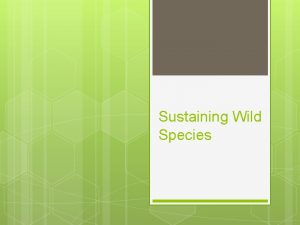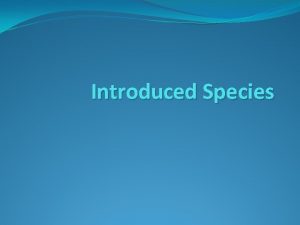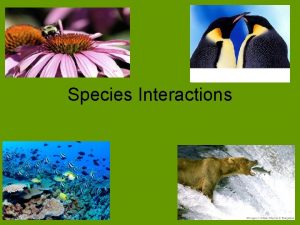Turf Weed Management Strategies Identify Weed Species and

























































- Slides: 57

Turf Weed Management Strategies Identify Weed Species and Determine Life Cycles Don’t assume you have the same weed or weeds as your neighbor. You may not even have the same turfgrass.


Turf Weed Management Strategies Weed Identification Risky method – but quick Ask your neighbors or friends. (They sometimes are wrong, and you can end up wasting money on ineffective control measures. )

Turf Weed Management Strategies Weed Identification Possible time consuming method – but reliable Dig up samples and take to your local county cooperative extension office for identification and a control recommendation. (If they can id at the office, this is not time consuming. If they can’t id, they will send your sample to the weed science department at NCSU. A reply could take days or weeks. )

Turf Weed Management Strategies Weed Identification When sending samples, collect healthy, normal growing weeds if possible and include above ground as well as below ground vegetation. Wrap weeds in moist paper towels to keep as fresh as possible and put in a plastic bag. Describe the area where the weed problem exists.

Turf Weed Management Strategies Weed Identification Quickest reliable method Learn to identify weeds by yourself. A diagnostic kit consisting of a magnifying lens and weed id guide or guides would be helpful. (The sooner you know the weed population, the sooner you can develop a weed management strategy. )

Turf Weed Management Strategies Weed Identification Guides To identify mainly from pictures, there are several excellent weed id guides for settings such as turfgrasses, crops, ponds and forests. Many of these guides include control options as well.

Turf Weed Management Strategies Weed Identification Guides Color Atlas of Turfgrass Weeds • Authors include, Mc. Carty, Everest, Hall, Murphy and (Yelverton – NCSU) • Includes control options

Turf Weed Management Strategies Weed Identification Guides Univ. of GA Cooperative Ext. Service Website • Identification and Control of Weeds in Southern Ponds • Poisonous Plants of the Southern United States • Weeds of Southern Turfgrasses • Weeds of Southern United States

Turf Weed Management Strategies Weed Identification Guides The Southern Weed Science Society • Forest Plants of the Southeast and Their Wildlife Uses • Weed Identification Guide

Turf Weed Management Strategies Weed Identification Guides Dr. Joe Neal Website - NCSU • • Identifying Seedling and Mature Weeds of Arkansas Weeds of Southern Turfgrass Weeds of the Northeast

Turf Weed Management Strategies Weed Identification Guides To identify weeds (plants) using keys that give plant descriptions that notice its essential characters, synonyms and place of growth, we at NCSU use books entitled… New Britton & Brown Illustrated Flora and also Turfgrass Pest Management Manual

Turf Weed Management Strategies Weed Identification Guides Problems associated with turf managers using botanical identification books such as New Britton & Brown Illustrated Flora… Identification based on flower and reproductive structures (these are constantly being removed by mowing – so you hardly ever get to see these) Mowed grasses are sometimes impossible to correctly id.

Turf Weed Management Strategies Weed Identification Guides Problems associated with turf managers using books such as New Britton & Brown Illustrated Flora… You would need to know scientific terminology of flower and reproductive structures, as well as other plant parts. (What are glumes, lemmas, stamens, pistils, etc…)

Turf Weed Management Strategies Weed Identification Guides An advantage using books such as New Britton & Brown Illustrated Flora… Contains thousands of grass AND broadleaf plants (you probably won’t have a specimen that is not listed) – Your plant sample can most likely be identified if you are persistent.

Turf Weed Management Strategies Weed Identification Guides Turfgrass Pest Management Manual • Keys out grasses only (weeds and turf) using vegetative instead of reproductive characteristics • Photos of grass and broadleaf weeds with general descriptions of growth characteristics • Consists of plants commonly grown in NC

Weed Biology 1. 2. 3. 4. 5. 6. 7. 8. 9. 10. Ten Most Common Weeds in North Carolina Turf Annual bluegrass Crabgrass species (smooth, large) Dallisgrass Chickweed species (common, mouseear) Goosegrass Henbit Clover species (white, hop) Dandelion Wild garlic Kyllinga species (green, false-green) 2000 Proceedings - SWSS

Weed Biology Ten Most Troublesome Weeds in North Carolina Turf 1. Annual bluegrass 2. Dallisgrass 3. Kyllinga species (green, false-green) 4. Crabgrass species (smooth, large) 5. Goosegrass 6. Virginia buttonweed 7. Purple nutsedge 8. Violet species 9. Yellow nutsedge 10. Wild garlic 2000 Proceedings - SWSS

Grass Vegetative Key Based primarily on… 1. Leaf vernation 2. Ligule 3. Auricle 4. Collar 5. Sheath 6. and also presence or absence of rhizomes or stolons

Grass Vegetative Key Leaf vernation is the arrangement of the leaves of the budleaf (youngest leaf) and surrounding sheath. Leaf vernations are either rolled or folded (Vshaped) in the bud leaf.

Grass Vegetative Key Grasses rolled in the budleaf include… Smooth crabgrass Bahiagrass Bentgrass Dallisgrass Tall fescue Foxtail species Annual ryegrass

Grass Vegetative Key Grasses folded in the budleaf include… Bermudagrass Bluegrass species Carpetgrass Centipedegrass Goosegrass Perennial ryegrass St. Augustinegrass

Grass Vegetative Key Ligule is a protruding structure from the upper leaf surface where the blade and sheath join. Ligules can be membranous (shiny), hairy, membranous with hairs or absent.

Grass Vegetative Key Creeping bentgrass Bluegrass species Smooth crabgrass Dallisgrass Tall fescue Annual ryegrass Perennial ryegrass have membranous ligules

Grass Vegetative Key Bermudagrass Carpetgrass Foxtail species St. Augustinegrass Zoysiagrass have hairy ligules

Grass Vegetative Key Bahiagrass Centipedegrass Goosegrass have membranous ligules with hairs Barnyardgrass does not have a ligule.

Grass Vegetative Key Auricle is a pair of appendages protruding from the sides of the grass leaf at the junction of the blade and sheath. Auricles can be rudimentary (short and blunt), large and clawlike or absent.

Grass Vegetative Key Tall fescue has short or blunt auricles. Annual and perennial ryegrass have large or clawlike auricles. The remaining previously-mentioned grasses have no auricles.

Grass Vegetative Key Collar is the region on the back side of a leaf where the leaf blade and sheath are joined. Collars can be divided by the leaf midrib or continuous, with shapes ranging from broad to narrow.

Grass Vegetative Key Bluegrass species Smooth crabgrass Tall fescue Foxtail species Perennial ryegrass have collars divided by a midrib

Grass Vegetative Key Bahiagrass, creeping bentgrass Bermudagrass, carpetgrass Centipedegrass, dallisgrass Goosegrass, annual ryegrass St. Augustinegrass, zoysiagrass have continuous collars

Why Weeds are Present in Turfgrass Weeds are the result of improperly managed turf.

What is Properly Managed Turfgrass? The turf species must be adapted to its environment. • Should you choose cool or warm season turf? • Is it shade tolerant? (St. Augustine, tall fescue, perennial bluegrass) • Does it require full sunlight? (Bermudagrass)

What is Properly Managed Turfgrass? Turf must be mowed at proper height and frequency. 3 Inch Turf Mowing Height Tall fescue / fine fescue / per. bluegrass mixtures

What is Properly Managed Turfgrass? 2. 5 Inch Turf Mowing Height Perennial bluegrass / perennial ryegrass mixtures Bahiagrass St. Augustinegrass

What is Properly Managed Turfgrass? 2 Inch Turf Mowing Height Perennial bluegrass / fine fescue

What is Properly Managed Turfgrass? 0. 75 – 1 Inch Turf Mowing Height Bermudagrass Centipedegrass Zoysiagrass

What is Properly Managed Turfgrass? The turf must be fertilized at the proper time with the proper rate and technique.

What is Properly Managed Turfgrass? Cool Season Turf Nitrogen Timings and Amounts For all cool season turf, start applications in September – October and finish in February – March. Do not apply nitrogen in the spring or summer because of disease concerns. 3 lbs of N per 1000 sq ft per year is sufficient.

What is Properly Managed Turfgrass? Warm Season Turf Nitrogen Timings and Amounts Timings and rates vary between species, but generally start in the spring and fertilize through summer. Do not apply nitrogen in the fall or winter. Total N rates range from 0. 5 lb per 1000 sq ft per year for centipedegrass to 6 lbs for hybrid bermuda.

What is Properly Managed Turfgrass? The turf site must be well drained, noncompacted and receive adequate rainfall or irrigation.

Indicator Weeds Some weeds prefer conditions such as low / high p. H, compaction, shade, dry / wet soils, or low / high nitrogen. Under these conditions, the turf may perform poorly, but these weeds will continually be a nuisance until the underlying problem is corrected regardless of the choice of herbicides.

Indicator Weeds The presence of an indicator weed suggests a condition but is not proof of a condition. It is not always feasible or practical to fix the underlying problem because of money, time or human nature.

Indicator Weeds Herbicides are short-term solutions and can’t compensate for poorly managed turf. Consider them as band-aids or duct tape (temporary fixes). Herbicides will not eliminate weeds permanently, but correcting the origin of turf stress may.

Indicator Weed Examples Low soil p. H High soil p. H Droughty soils Wet soils Red sorrel Broadleaf plantain Spotted spurge, black medic, knotweed, woodsorrel species, lespedeza, bracted plantain Sedge and kyllinga species, annual bluegrass, goosegrass, moss, algae

Indicator Weed Examples High nematodes Low mowing height Low soil nitrogen High soil nitrogen Spotted spurge, prostrate knotweed, Florida pusley Annual bluegrass, chickweed species, algae Legumes (clover, chickweed and speedwell species, black medic, chicory), broomsedge, bitter sneezeweed Annual bluegrass, ryegrass species, moss

Indicator Weed Examples Poor (sandy) soil Compacted soil Shade Sandspur, poorjoe, quackgrass Annual bluegrass, goosegrass, prostrate knotweed, spotted spurge Ground ivy


Weed Control Procedures A successful weed management strategy should integrate all of these procedures and not rely heavily on one. Preventative Mechanical Biological Cultural Chemical

Weed Control Procedures Preventative • Good sanitation Clean mowers, tillage implements and other turf equipment before moving to new sites to remove weed seeds and vegetative material.

Weed Control Procedures Mechanical • Physical removal by hand or tillage Effective on annual weeds when the growing point is removed or buried Ineffective on perennial weeds that have underground storage organs unless done repeatedly

Weed Control Procedures Mechanical • Mowing Effective on many annual broadleaf weeds that have an upright growth habit Ineffective on common broadleaf weeds such as prostrate knotweed, spotted spurge and common lespedeza because of low growth

Weed Control Procedures Mechanical Mowing (continued) Mowing prevents seed formation in annuals. However, mowing is generally not effective on grassy weeds and many perennial weeds. One exception for perennial weeds is yellow nutsedge, which can’t produce tubers with frequent mowings at 1. 5 inches or less.

Weed Control Procedures Biological weed control utilizes natural enemies such as insects, fungi, bacteria and nematodes. This method is generally limited to large areas where a single weed dominates and other control methods are not practical. Example – thistle control in rangelands with weevils

Weed Control Procedures Biological Turf example with limited success: Xanthomonas campestris (bacteria) on annual bluegrass Mow and immediately apply bacteria which enters the cut surfaces to produce wilt which kills the plant Biologicals don’t give rapid kill like chemicals. This is not enticing to many consumers. People usually want problems fixed quickly.

Weed Control Procedures Cultural The best way to prevent weed problems in turf is to properly manage the turfgrass. • Select an adapted grass species • Mow at proper height and frequency • Fertilize at proper time and rates • Irrigate as needed in morning, not late evening • Improve soil drainage by adding soil or soil mixes

Weed Control Procedures Chemical The quickest way to prevent weed problems in turf is to apply herbicides. Herbicides are short-term solutions. Results can be seen quickly, and people are happy. Herbicides do not correct the problem as to why weeds were present in the first place. As long as the problems are not corrected, the need for herbicides will exist.
 Category e turf and ornamentals
Category e turf and ornamentals Turf areas in xeriscaping designs should be seeded in
Turf areas in xeriscaping designs should be seeded in Turf toe
Turf toe Contact sports
Contact sports What is the role of nitrogen in plants
What is the role of nitrogen in plants Turf insects identification
Turf insects identification Hydraulic cylinders for turf maintenance
Hydraulic cylinders for turf maintenance Can plants be keystone species
Can plants be keystone species Disadvantages of iwm
Disadvantages of iwm Sustainable weed management
Sustainable weed management Weed and confidence
Weed and confidence Implementing strategies management and operations issues
Implementing strategies management and operations issues Implement strategies management issues
Implement strategies management issues Implementing strategies: management and operations issues
Implementing strategies: management and operations issues Strategic business unit structure
Strategic business unit structure Ch 7
Ch 7 Cockroach control teton county
Cockroach control teton county Jewel weed medicinal
Jewel weed medicinal The thallus of a macroalgae/seaweed refers to its
The thallus of a macroalgae/seaweed refers to its Weed eradication definition
Weed eradication definition Mia's growing like a weed answers
Mia's growing like a weed answers Weed science definition
Weed science definition Sniffable weed
Sniffable weed Texas pasture weeds
Texas pasture weeds Weed control murphy
Weed control murphy Accident weed diagram
Accident weed diagram Negative effects of weed on teenage brain
Negative effects of weed on teenage brain Less is more coco chanel
Less is more coco chanel Harmful effects of weeds
Harmful effects of weeds Cannabis pesticides
Cannabis pesticides Mayil kondai weed
Mayil kondai weed Onion weed in lakes
Onion weed in lakes Alien weed definition
Alien weed definition Economic importance of weed
Economic importance of weed Corn weed blocker
Corn weed blocker Veganic weed
Veganic weed Sandspur removal kit
Sandspur removal kit Weed wrench
Weed wrench Mary jane herb
Mary jane herb Weed hun
Weed hun Dy b
Dy b Sunlink weed of the month
Sunlink weed of the month Accident weed
Accident weed Biological weed control
Biological weed control Wysoccan ceremony
Wysoccan ceremony Herndon montana
Herndon montana Division plant
Division plant Green assassin weed killer
Green assassin weed killer Weed millionare
Weed millionare La la laitiere weed
La la laitiere weed Ganga weed
Ganga weed Bell ringer drugs
Bell ringer drugs Cda rotary
Cda rotary Diana browning
Diana browning 17 proactive classroom management strategies
17 proactive classroom management strategies Diana browning wright
Diana browning wright What is layout strategy
What is layout strategy Visitor management techniques in tourism
Visitor management techniques in tourism
